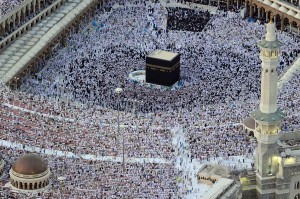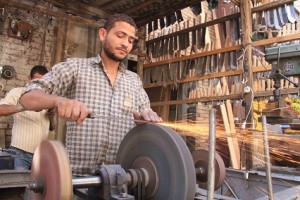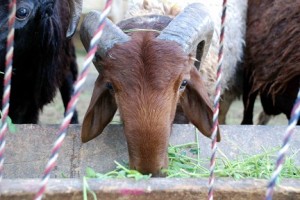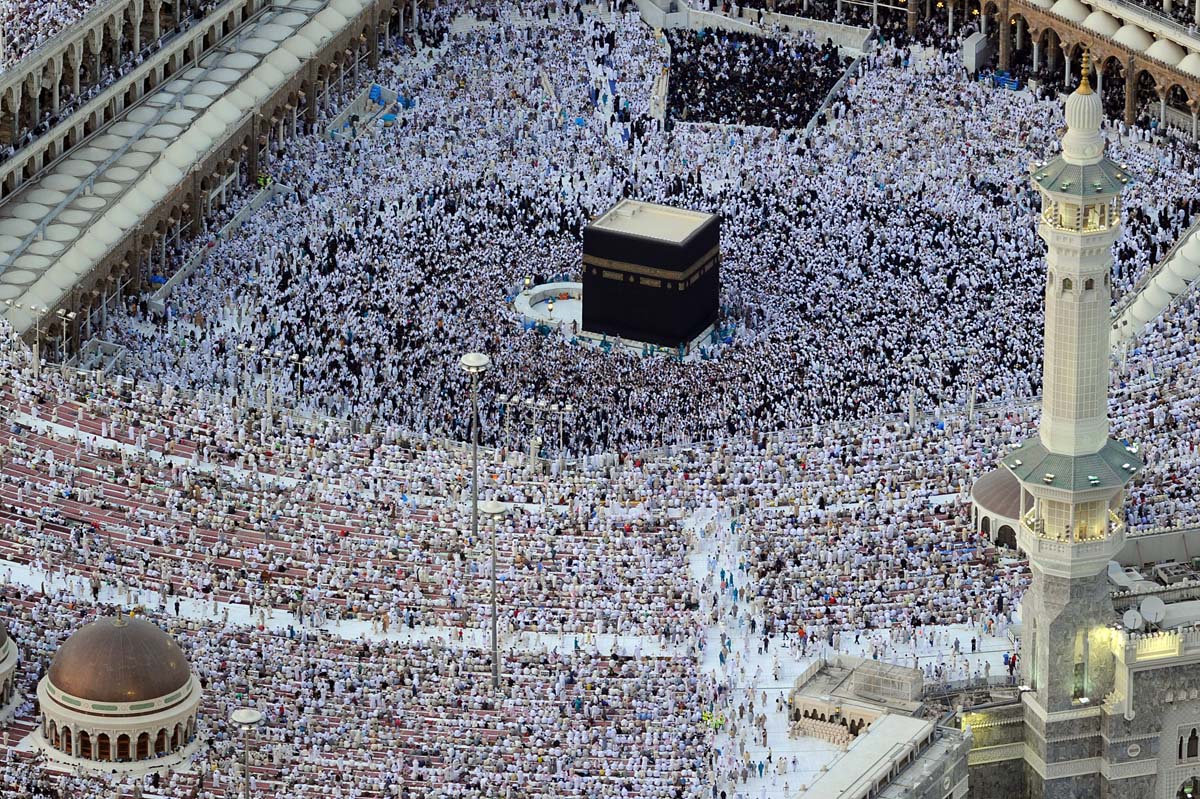By Rana Muhammad Taha, Nouran El-Behairy and Hend Kortam
All the little details perfectly fit together by the first day of Eid, as Egyptians diligently divide their time between religious obligations and social customs. The line between what is done for religious reasons and what’s done for social ones soon disappears as they all melt into sacred traditions.
Eid Al-Adha, also called the Feast of Sacrifice or the Greater Bairam, is one of two important religious holidays celebrated by Muslims worldwide; it comes about 70 days after Eid Al-Fitr, the second most important feast which celebrates the end of the fasting month of Ramadan. Al-Adha starts on day 10 of Dhu-Al-Hijja, the twelfth month of the Islamic Hijri calendar, and ends on the 13th.
Eid-eve 101
The overcrowded streets, people everywhere buying clothes to celebrate with a new outfit, Om’ Kalthoum’s Ya Leilet Al-Eid (oh, Eid-eve) song echoing everywhere in the background; the spirit is quite similar to that of the Fitr Eid.
Except for all the sheep that is. Already one week ahead of the Eid, sheep can be spotted everywhere. You can see cattle occupying the streets too, crammed in little fenced spaces, awaiting their slaughter. You find them herded in some corner of the street, staring at you from behind a secluded car, or maybe even interrupting your ride by abruptly passing in front of you. And why wouldn’t they, when no season witnesses such abundance in slain sheep and cattle as that of the Adha Eid season?
This second Eid in the Islamic Calendar lasts four days. While Muslims all over the world are celebrating the Eid with their age-honored different traditions in different countries and regions, the celebrations are in conjunction with Hajj, pilgrimage to Mecca and commemorate the story of Ibrahim who was ordered to sacrifice his son Ismail.
Hajj

Hajj is Arabic for pilgrimage. Muslims from all over the world flock to Mecca to start their pilgrimage which takes several days. The day before they begin hajj, Muslims gather on the Arafat plain outside Mecca, a day which is named wa’fa. The next day in Mecca, they perform tawaf, which is the act of walking around the Ka’ aba seven times, and sa’y, which is walking back and forth seven times between the Safa and Marwa mounts in Mecca.
Over the course of the next few days, the pilgrims have to collect pebbles from a place called Mozdalefa where they will throw them at symbolic pillars which represent Satan. There are three pillars, represent the three times in which Satan tried to challenge Ibrahim to prevent him from sacrificing his son, Ismail, to God. The stone throwing is followed by two more tawafs in Mecca; the last is called the farewell Tawaf, before the pilgrimage is over.
Hajj is among the most sacred religious rituals, it is the fifth pillar of Islam. However, not everyone manages to perform it. The cost of Hajj varies, but it usually starts at thousands of Egyptian pounds in accommodation and transportation to perform Hajj, which is why many people can’t afford it.
The sacrifice of Ibrahim
The name Feast of Sacrifice commemorates the willingness of prophet Ibrahim to sacrifice his son Ismail in submission to Allah’s command.
Ibrahim saw a recurring dream of himself slaughtering his son Ismail; he knew that dreams of prophets are communications from Allah, so he decided to consult his son, whom he had after years of prayers, before implementing the divine command.
Satan tried to dissuade Ibrahim from carrying out the command but Ibrahim pelted him with stones.
Ismail submitted without hesitation, and as Ibrahim was about to slaughter him, Allah intervened and provided Ibrahim with a ram to sacrifice instead. They both passed the test of faith, devotion and determination to submit to the will of Allah, no matter what or who would be sacrificed.
The story is mentioned in Quran in Surat Al-Saffat from 37: 100 to 37: 107 “My Lord, grant me [a child] from among the righteous, So We gave him good tidings of a forbearing boy, And when he reached with him [the age of] exertion, he said, ‘O my son, indeed I have seen in a dream that I [must] sacrifice you’”
Fasting
The wa’fa which is the ninth of Dul-Hijja, and the day that precedes the Eid, is a fasting day for most Muslims. Religiously speaking, the whole nine days before the Adha Eid are days where fasting is highly encouraged as they’re the first nine days of Dhu-Al-Hijja. Fasting on the wa’fa is even more sacred, though none are religiously obligatory. Usually, most Egyptians take that day off, dividing their time between resting and preparing an adequate meal to break their fast. It is one special day where the spirit of the holy month of Ramadan is almost revived.
On Eid
The day of Eid starts with Eid prayer. Al-Adha has a special prayer; it takes place sometime after Fajr when the sun loses its reddishness. It’s a congregational prayer that consists of two rak’ ah (praying units) followed by a sermon, which is usually given by the Imam.
The ruling of Eid prayer is disputed among scholars, some maintain the prayer is compulsory and thus those who do not pray without reasonable excuse are sinners; while others hold it is recommended but not obligatory.
Muslims start reciting Takbeer (chants praising Allah) from the dawn of the first day of Eid (10 Dhu-al-Hijja), there are different variations to Takbeer, but the most common one in Egypt was the one adopted by Imam Shafei, the scholar whose opinions are mostly followed by Egyptians beginning: “Allah is the Greatest, Allah is the Greatest, Allah is the Greatest, there is no deity but Allah, Allah is the Greatest, Allah is the Greatest and to Allah goes all praise.” The Takbeer is chanted by Muslims on the first day of Eid, as pilgrims in Mecca are also reciting the same Takbeer.
The rightful slaughter

After the prayer comes the ritual of sacrificing the animal which is usually a sheep, goat, cow, ram or camel. The sacrifice has certain criteria, regarding the age, the health condition and the ownership of the animal. The sacrifice can be made anytime from after the prayer on the first day of Eid until the sunset of the fourth day.
For a few days before and after the Adha Eid, the streets of Cairo are filled with blood from the slaughtering of the cattle. It is impossible to avoid the sight of blood, inches high in some places. In some neighbourhoods, if you’re on the street after a cattle beast was slaughtered you will see the butchers, at their most lucrative time of the year, covered in blood and with an array of different sized knives in their pockets.
Slaughtering cattle in Islam follows certain rules regardless of whether it is Eid or any normal day.The difference is that in Eid, the act itself is a religious symbol. Doctor Mohamed Mokhtar Al-Mahdy, a member of the committee of the senior Al-Azhar scholars and head of the Legitimate Committee for the Supporters of the Sunnis, explained the rules that must be followed when slaughtering the cattle and the extent to which they are followed in Egypt.
“ The rightful slaughter in Islam, and Christianity and Judaism is unified. It is cutting the veins but not directly beneath the chin, you leave a vertebra or two and then slaughter the animal and wait for the blood to drain,” he said.
“The cattle is slaughtered in the direction of the Qibla and the person who slaughters it has to say ‘Allahu Akbar’, Al-Mahdy added. He said that the words “God is Great” have a huge significance when slaughtering. “It means that I have not assaulted this animal, but I am slaughtering it in the name of God” Al-Mahdy explained.
Al-Mahdy said that these words mean that God has created both the slaughterer and the animal and that he is more powerful than both of them.
Al-Mahdy spoke about the need to be merciful towards the cattle when slaughtering it. “ The animal should not see the knife before it is slaughtered and should not be slaughtered in front of a slaughtered animal,” Al-Mahdy said. Often, animals will be slaughtered in the same place. Once they witness the slaughtering of another animal, they are in shock. “ This way the animal is tortured,” he said.
Al-Mahdy described the current way in which the animals are slaughtered, in which they may witness other animals being slaughtered as wrong and cited a Hadith (saying) of Prophet Mohamed proving that it is wrong to subject the animals to this. He added that before slaughtering the animals, the blade of the knife that is going to be used to slaughter the cattle must be sharpened.
The meat is then divided into three shares, the family retains one third to eat, another goes to relatives, neighbours and friends and the third is distributed among the poor. It was also recommended by scholars to carry out the sacrifice right after the prayer to be able to have its meat for breakfast.
The feast and family get together
Like any Egyptian celebration, the Adha Eid is famous (or rather notorious) for its special meals. Unlike the Fitr Eid where you have sweet, sugary Kahk for breakfast, the Adha is all about the meat. Yes, ladies and gentlemen, Egyptians have meat for breakfast, be it stir-fried liver or meat cubes; and it might well be coupled with some delicious Fatta (rice with toasted bread chips and tomato sauce).
The meat intake doesn’t quite die out by lunch/dinner time but there is some slight variation. If one hasn’t already taken their generous share of Fatta and meat cubes, it is mandatory that they do so during lunch. Otherwise, lots of other Egyptian dishes are waiting in line, ranging from the classic Ro’ a’ (crispy pie-like dough layered with minced meat) and the ever popular lamb cutlets.
Putting the food department behind us, other priorities also fall into place; namely family reunions. If the entire family doesn’t get together to share this mouthwatering banquet, then they’re sure to meet up some time after lunch. It is at that time when grown- ups get to catch up and little kids get to show-off their new Eid clothes and spend their entire Eid allowances, Eideyas, on homemade fireworks.
The exchange of greetings and visits was recommended by prophet Mohamed; some scholars even mentioned that he encouraged Muslims going to the Eid prayer to take a different route as they returned home, to get the chance to meet and greet more people.
These activities aim to bring Muslims closer together and to encourage helping the poor by seeing that no one is left without meat during Eid.
Slaying sheep

For devout Muslims, there’s three different ways of being true to the sheep slaying ceremony during Eid. Traditionally families would take a trip to the countryside hunting for a suitable sheep. The preliminary trip would take place a couple of weeks before Eid. Another mandatory trip, usually on the wa’fa morning, would see the chosen sheep brought back to the family home, where it would live outside in the garden or street waiting for the big day. The next morning the family would slaughter the sheep they had been petting just the day before.
Next is the second method, much easier and more civil. The father would take the preliminary trip all by himself, choosing the right sheep. Then, he’d save the big trip until the first Adha Eid day, where he’d have the sheep slain back in the village and come back home with the meat. Much more convenient than the first method, but still nothing on the third way.
The sacrificial voucher; a certificate you get for paying a certain amount of money to a certain charity enables you to keep you hands clean entirely. The charity, using your money, takes care of buying the sheep, has it slain on the Adha Eid, then distributes its meat among the poor, including those residing in poorer areas outside of Cairo and therefore outside of most Carienes’ reach. Some organisations even offer to provide you with a portion of the slain sheep so that you can distribute it among the poor yourself. Not only is it more efficient in terms of delivering the meat to those who need it the most, but level number three is also the most convenient.
Despite it being more convenient, some people still prefer older and more traditional methods of slaying the sheep by themselves or at the butcher’s. Butcher Salem Mohamed, who has a butchery in Al-Haram suburb of Giza, said that there is no permit or license that a butcher has to get from the government. Any butcher can just slaughter the animals he said.
He says that the sales are much lower than previous years. Mohamed is hoping that sales will rise as Eid approaches. “ We are only praying to God that they will.”
Mohamed said that the price of meat hasn’t changed a lot from last year, except for the price of sheep. “One kilo of lamb costs around EGP 70 or more,” Mohamed said. Mohamed said it differs depending on the neighbourhood. “A kilo of calf meat costs around EGP 75 to 80, again depending on the neighbourhood. In some areas it costs EGP 100 and a kilo of older cow or buffalo meat costs around EGP 65 to 70.”
Regardless of how you choose to observe the festival, it is vital a sheep or cattle gets slain on the first Adha Eid day (or the second in some rare instances outside of Cairo), you have a good number of meat pastries ready for distribution, and any poor passersby get to knock on your door and demand their share of this year’s sacrifice.
Though made up of four long days, the first Adha Eid day is always the most significant. When it comes to an end, it feels as though the entire Eid has passed us by, despite the fact that three more Eid days are waiting to be enjoyed.




